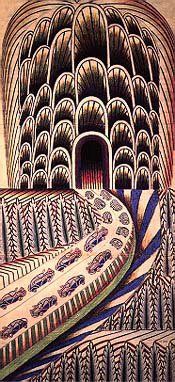 |
 |
 |
 Vallarta Living | Art Talk | April 2007 Vallarta Living | Art Talk | April 2007  
Jalisco's Martín Ramírez Wins Recognition
 El Universal El Universal


| | Untitled, Martin Ramirez, Auburn, California, c. 1954, pencil, colored pencil, watercolor, and crayon on paper, 52 15/16 x 23 15/16 inches, Solomon R. Guggenheim Museum, New York |
His studios were California mental wards, his canvas bits of paper assembled from trash bins and his pigments melted crayons.

Self-taught draftsman Martín Ramírez dealt with schizophrenia and estrangement from his family in Mexico with an outpouring of hypnotic drawings and collages unique in 20th-century art.

So popular and critically acclaimed are Ramírez´s 96 works on display at the American Folk Art Museum that it announced a two-week extension of the three- month retrospective until May 13 and added another museum to the show´s itinerary.

The retrospective curated by Brooke Anderson is the first to interpret Ramírez´s work in the context of his difficult life and times.

"Visitor attendance for this exhibition is the highest in the museum´s history," said public relations director Susan Flamm. "On weekends, we´re getting 1,000 visitors a day, which is a lot for a small museum. The catalog has gone into a second printing."

The added stop is the San Jose Museum of Art in California, from June 9 to Sept. 9. Then it travels to the Milwaukee Art Museum Oct. 6 through Jan. 7, 2008.

The show´s loans from private collections and museums in the United States, Mexico and Europe represent about one-third of Ramírez´s 300 surviving works.

These compositions were largely viewed as curiosities from a mute "schizophrenic artist" at a few public showings before his death in 1963 at age 68. Now his works command tens of thousands of dollars or more on the art market, Flamm said.

Ramírez composed in a diverse figurative style with detailed, symmetrical motifs that fused his recollections of growing up in rural Jalisco, his migrant worker years in California and confinement after his mental breakdown.

Inventive draftsmanship and extraordinary manipulations of spatial elements characterize his drawings and collages, many in the 24-inch-by-36-inch range, some much larger.

Stage-like settings of precise vertical and horizontal lines or curving whorls resembling terraced mounds often frame Ramírez´s subjects: cowboys with pistols astride steeds; serpentine trains or lines of vehicles flowing toward dark tunnels; Madonnas with spiked headdresses and long gowns.

Figures on one side of the drawing, such as miniature animals, humans, trees, invariably have mirror images on the other side of the picture in what seems to be the artist´s compulsion for balancing elements.

Perhaps the greatest work on display is a colorful, untitled landscape, completed between 1948 and 1963, on longtime loan to the folk art museum.

It combines all the figurative elements Ramírez used - rural and urban buildings, railroads and automobiles, Madonnas, quilt-like decorative motifs and farming photos clipped from magazines.

Assembled from castoff sheets of paper glued like a mosaic, this extraordinary work measures nearly 9 feet (2.74 meters) long and 4 1/2 feet (1.4 meters) high.

Even though Ramírez had no formal art training, the vast panorama evokes historical styles and elements as diverse as Renaissance paintings and Picasso-like modernism.

BORN IN JALISCO

He was born in 1895 in rural Jalisco, married a local young woman at age 23, with whom he had three daughters and a son. Ramírez bought a small piece of land on credit in 1923, but with economic troubles and political unrest in the region, he decided to go to the United States for better earnings.

He worked on the railroads and in mines in northern California from 1925-30, then suffered a mental breakdown in early 1931. Committed to Stockton State hospital, he was initially diagnosed with manic depression. After two years of treatment, the diagnosis was changed to dementia praecox, catatonic form.

Ramírez sent home his first drawings on the margins of letters in the late 1920s. While hospitalized in the mid-1930s, he began to draw more regularly.

It was during this time that he came to believe, wrongly, that his wife had sided with federal forces against local rebels, and he broke off contact with his family.

His only contact thereafter was with a nephew who visited him at DeWitt State Hospital in Auburn, California, where he was transferred in 1948, according to a museum chronology.

Tarmio Pasto, a professor of psychology and art at Sacramento State College, met Ramírez in 1948 at DeWitt, recognized his talent and helped obtain art supplies.

Before that assistance, Ramírez manufactured his own materials largely from food and castoffs salvaged from the hospital.

Pasto later arranged Ramírez´s first exhibits in northern California in the 1950s.

He preserved the works and helped bring them into the art market after the artist´s death. | 
 | |
 |



